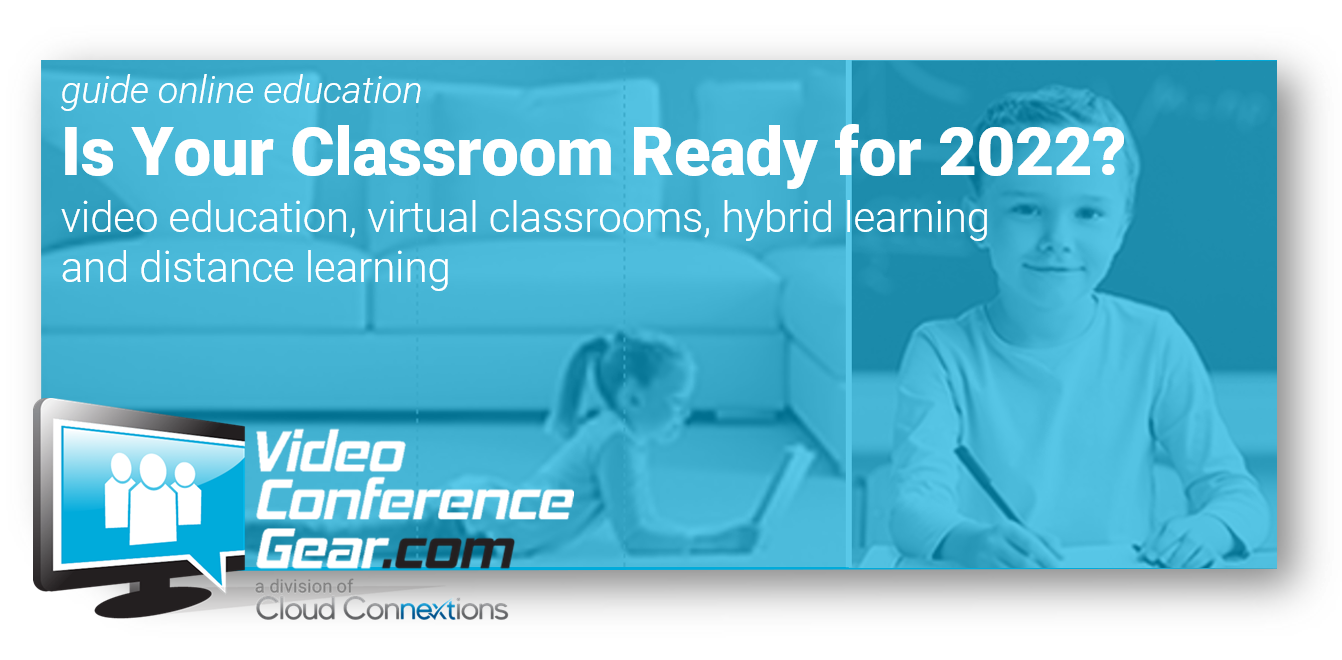Online Education - Is Your Classroom Ready for 2022?
Posted by Video Conference Gear on 4/7/2021

Just a little over a year ago, video education was considered "leading edge" and only the largest schools and universities could afford the heavy upfront investment for equipment, space and a team of people to manage it.
Fast forward to 2021 and the investment has shrunk to pennies on the dollar. You can now "video enable" a classroom for less than $6,000 (in fact, we have classroom kits for less than $2000). And supporting those rooms does not take an army of technical wizards either - any classroom can be up and running in less than a couple days.
Cost and technical expertise is no longer a barrier for school education practices. What holds many people back is perception, more than reality. There is still a perception that video education is difficult, or it requires specialized technical knowledge to setup and keep running. The difference between today and the past, is now video education is "software based", meaning most of the complicated video and audio capabilities are now managed by software, rather than hardware.
Support has not gone away, you still need to manage the software licenses, train and support students and faculty, manage room hardware, etc. but it has been simplified. In fact, the latest versions of Zoom now support consolidated, remote management room hardware, which allows "management" of Zoom Rooms remotely. On-site personnel are no longer required to solve most problems.
Picking the right products is key when moving into the world of online and hybrid education and reaping the benefits of connecting with students, teachers, and faculty.
But how to make the "right" decision when you do not necessarily know the right questions to ask. The key to getting started is understanding two things about your classrooms:
1. WHAT classrooms do you want to have "video education" enabled?
Rarely would any school or university completely transform all their classrooms into online video education spaces. Most of our current school and university partners start off with either a small room or a single classroom. There are a lot of things you want learn from this startup phase, including how much the room will be used, how much time/effort it takes to train your staff and students, what type of support is required (either internally or from an external support group), etc.
Have a plan on the type of space goes a long way in determining what hardware you need. The options are not endless, most rooms have the same basic setup - Display, Camera, Microphones, Speakers, and Room Controls. The decisions for the type of each of those products is limited (or expanded) by the room size.
For example, different products would be used if the classroom is in "open space" or if it is enclosed, like a typical classroom. There are Cameras specialized if the room has extreme light conditions, such as having windows facing East or West. Also, there are Audio products which provide both standard voice (phone calls) and video display, along with Bluetooth enabled audio products.
That's why, determining the room size is a key decision, because the size will determine which products fit best.
2. HOW do you want to use your online video education classrooms?
Once you've determined the room size, you have to determine how you are going to use that space. We all know there are some rooms within our Schools and Universities that are better for small groups, and others for large groups. Do you have lots of small groups that need to be together? Are your students in different locations? Do you have remote education and students, are they clustered in a single location or at home?
One of the key benefits, besides being able to see staff and students in the digital classroom, is sharing files, collaborating on projects, reviewing homework assignments, etc. But this is not limited to only to online sharing. Online video education allows everyone in the classroom to have an "in room" experience, that means if you have whiteboards (either smart or not), you can show what is being written/drawn in real time.
Understanding if the classroom will be primarily used for teachers, remote learning, student interactions, hybrid education, or anything number of other uses, that will dictate what products fit best.
Regardless of where you start, it is important to understand online education does not need to be difficult, in fact, it should be used to enhance your school’s current communication and how your staff teaches today. The benefits far outweigh any disadvantages. For most of our schools and Universities, once they start down the path of adding video learning into their classrooms, they do not stop, they accelerate.
If you have any questions, please do not hesitate to reach out to us. We are here to ensure you have the right products for your goals.
3. Learn from Home or Learn at School
As we progress through 2021, there are more and more schools looking to move from 100% in-school teaching to some level of hybrid online education. As this shift happens, it becomes important to understand the support requirements for helping those learning from home (a) get the best hardware setup possible and (b) support them just like they are in the classroom. We have developed OnDemand support services any school can leverage to provide their remote students and staff fast and affordable support when they run into problems. We also have products available specific for home use to enhance the video education experience.
Online learning should be simple, let us help you simplify the digital teaching experience. Browse our entire catalog for the best video conferencing products available on the market today, click here to get started.
